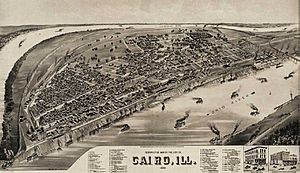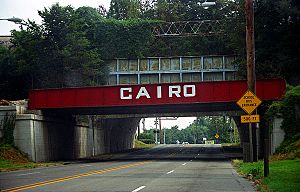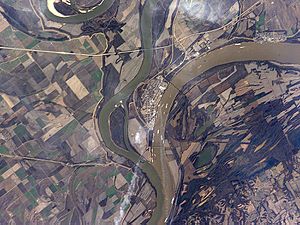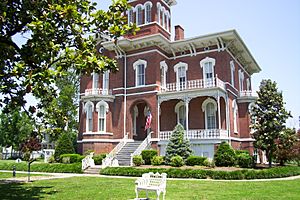Cairo, Illinois facts for kids
Quick facts for kids
Cairo, Illinois
City of Cairo
|
|
|---|---|

Washington Avenue in Cairo, Illinois
|
|
| Etymology: Cairo, Egypt | |
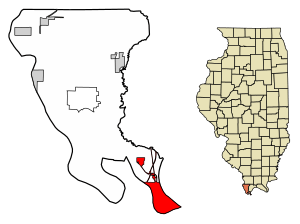 |
|
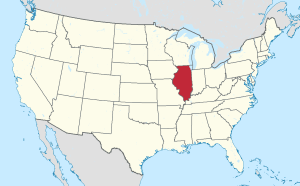
Location of Illinois in the United States
|
|
| Country | United States |
| State | Illinois |
| County | Alexander |
| Area | |
| • Total | 9.11 sq mi (23.59 km2) |
| • Land | 6.99 sq mi (18.10 km2) |
| • Water | 2.12 sq mi (5.49 km2) |
| Elevation | 315 ft (96 m) |
| Population
(2020)
|
|
| • Total | 1,733 |
| • Density | 248.03/sq mi (95.77/km2) |
| Time zone | UTC−6 (CST) |
| • Summer (DST) | UTC−5 (CDT) |
| ZIP Code |
62914
|
| Area code(s) | 618 |
| FIPS code | 17-10383 |
| Wikimedia Commons | Cairo, Illinois |
Cairo ( KAIR-oh) is the southernmost city in Illinois and the county seat of Alexander County.
The city is located at the confluence of the Ohio and Mississippi rivers. Fort Defiance, a Civil War camp, was built at the confluence in 1862 by Union General Ulysses S. Grant to control strategic access to the river. Cairo has the lowest elevation of any location in Illinois and is the only Illinois city to be surrounded by levees. It is in the area of Southern Illinois known as Little Egypt.
Several blocks in the town comprise the Cairo Historic District, listed on the National Register of Historic Places (NRHP). The Old Customs House is also on the NRHP. The city is part of the Cape Girardeau–Jackson, MO–IL Metropolitan Statistical Area. Being bypassed by transportation changes and industrial restructuring cost many jobs: the population at the 2020 census was 1,733. The city's peak population was 15,203 in 1920.
The entire city was evacuated during the 2011 Mississippi River Floods, after the Ohio River rose higher than the 1937 flood levels, with the possibility of 15 feet of water inundating Cairo. The United States Army Corps of Engineers breached levees in the Mississippi flood zone near Cairo in Missouri to prevent flooding in Cairo and other more populous areas further downstream along both the Ohio and Mississippi rivers.
Contents
History
Beginnings
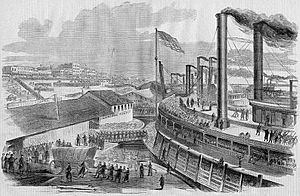
The first municipal charter for Cairo and for the Bank of Cairo were issued in 1818, bit without any settlement and without any depositors. A second and successful effort to establish a town was made by the Cairo City and Canal Company in 1836-37, with a large levee built to encircle the site. However, this effort collapsed in 1840, with few settlers remaining.
Charles Dickens visited Cairo in 1842, and was unimpressed. The city would serve as his prototype for the nightmare City of Eden in his novel Martin Chuzzlewit. In 1846, 10,000 acres in Cairo were purchased by the trustees of the Cairo City Property Trust, a group of investors who planned to make it the terminus of the projected Illinois Central Railroad, which finally arrived there in 1855. A new city charter was written in 1857, and Cairo flourished as trade with Chicago spurred development. By 1860, the population had exceeded 2,000.
In January 1862, during the Civil War, however, General Ulysses S. Grant occupied the city, and he and Admiral Andrew Hull Foote made the city their headquarters. Cairo would become an important supply base and training center for the rest of the war. Grant's military occupation caused much of the city's trade to be diverted to Chicago, and Cairo failed to regain it after the war. Instead, agriculture, lumber, and sawmills now dominated the economy.
Post-war prosperity
The strategic importance of Cairo's geographic location during the Civil War did spark prosperity. Several banks were founded during the war years, and the growth in banking and steamboat traffic continued after the war. Even before that, Cairo had been becoming an important steamboat port, and the city had been designated as a port of delivery by Act of Congress in 1854.
In 1869 construction began on the United States Custom House and Post Office, which was designed by Alfred B. Mullet, the Supervising Architect. The custom house was completed in 1872. It served as a custom house, post office, and United States Court. The U.S. District Court for the Southern District of Illinois met at the building until 1905. From 1905 to 1942, the building housed the U.S. District Court for the Eastern District of Illinois. The building also housed the U.S. Circuit Court for the Eastern District of Illinois from 1905 to 1912. The post office in the building was the third busiest in the United States at the height of Cairo's prosperity. One of only seven of Mullet's Victorian structures remaining in the nation, the building has been converted into a museum. It is listed on the National Register of Historic Places.
After the Civil War, the city became a hub for railroad shipping in the region, which added to its economy. By 1900 several railroad lines branched from Cairo. In addition to shipping and railroads, a major industry in Cairo was the operation of ferries. Into the late 19th century, nearly 250,000 railroad cars could be ferried across the river in as little as six months. Vehicles were also ferried, as there were no automobile bridges in the area in the early 20th century. The ferry industry created numerous jobs in Cairo to handle large amounts of cargo and numerous passengers through the city.
Wealthy merchants and shippers built numerous fine mansions in the 19th and early 20th century, including the Italianate Magnolia Manor, completed in 1872, and the Second Empire Riverlore Mansion, built by Capt. William P. Halliday in 1865. Across the street from the customs house, the Cairo Public Library was constructed in 1883 of Queen Anne-style architecture, finished with stained glass windows and ornate woodwork. The library was dedicated on July 19, 1884 as the A. B. Safford Memorial Library. Anna E. Safford paid for the construction of the Library and donated it to the city. These and other significant buildings are also listed on the National Register.
For protection from seasonal flooding, Cairo is completely enclosed by a series of levees and flood walls, due to its low elevation between the rivers. Several buildings, including the old custom house, were originally designed to be built to a higher street level, to be at the same height as the top of the levees. That plan was scrapped as the cost of fill to raise the streets and surrounding land to that height proved to be impractical. In 1914 a large flood gate was constructed by Stupp Brothers of St. Louis, Missouri. The flood gate is known as the "Big Subway Gate", and it was designed to seal the northern levee in Cairo by closing over U.S. Highway 51. The gate weighs 80 tons, is 60 feet wide, 24 feet high and five feet thick. With the addition of the gate, Cairo could become an island, completely sealed off from approaching flood waters.
Following the Great Mississippi Flood of 1927, the levee system around Cairo was strengthened. As part of this project, the Corps of Engineers established the Birds Point-New Madrid Floodway. The Ohio River flood of 1937 brought a record water level to Cairo that crested at 59.5 feet. To protect Cairo, Corps of Engineers closed the flood gate and blew a breach in the Bird's Point levee for the first time to relieve pressure on the Cairo flood wall. Following the flood, the concrete flood wall was raised to its current height. It is designed to protect the town from flood waters up to 64 feet.
In 1942 the federal government constructed a new U.S. Post Office and Court House in Cairo. Still growing, the city had a population approaching 15,000. The new federal court house, located at 1500 Washington, was designed by the architects Louis A. Simon and George Howe. The U.S. District Court for the Eastern District of Illinois moved into the new court house in 1942, from the old U.S. Custom House and Post Office. After the U.S. district court structure in Illinois was reorganized in 1978, the court house was used for the U.S. District Court for the Southern District of Illinois. The building remains in use by the federal courts and as the active post office for Cairo. The court house was built and is operated by the U.S. General Services Administration.
Economic decline
The slow economic decline in Cairo can be traced back to the early 20th century. In 1889 the Illinois Central Railroad bridge was completed over the Ohio River, which brought about a decline in ferry business. The economic impact was not severe, as the railroad traffic still was directed through Cairo, and automobile traffic would also increase in the early 20th century. In 1905 a second bridge was constructed across the Mississippi River at Thebes, Illinois. The effects of the second bridge were felt much more, as rail traffic through Cairo was now reduced and ferry operations for the railroad were no longer necessary. As the steamboat industry was replaced with barges, there was no longer a significant reason for river traffic to stop in Cairo.
In 1929, the Cairo Mississippi River Bridge was completed, linking Missouri with Illinois to the south of Cairo. In 1937 the Cairo Ohio River Bridge was completed. With the two bridges completed, there was no longer a need for any kind of ferry industry at Cairo. Additionally, both bridges cross the rivers to the south of town, which allowed motorists to cross the southern tip of Illinois between Missouri and Kentucky by completely bypassing the city of Cairo. While the city was protected by its levees from destruction when the Ohio River rose to record heights during the 1937 flood, the city's decline continued.
Racial tensions and further decline
With river traffic and rail traffic drastically reduced, much of Cairo's employment prospects were gone with them. Between the 1930s and 1960s, the population in Cairo remained fairly steady; however, many of the employment opportunities were no longer available as the shipping, railroad, and ferry industries left the city. Population decline was already beginning; however, it was not the rapid decline that Cairo would later experience. In a city that had such a strong history of racial violence, racial tension was strained once again by the late 1960s as the United States was in the middle of the Civil Rights Movement. This tension further damaged the already declining economy of the city.
The death of Robert Hunt sparked aggressive protests in Cairo's black community, and on July 17, 1967, a large portion of the black population in Cairo began rioting. The black rioting that erupted in 1967 was not confined to Cairo; it was part of a larger pattern of more than 40 racially motivated riots that occurred across major cities in the United States in the summer of 1967. During the night of rioting on July 17, three stores and a warehouse in Cairo were burned to the ground, and windows were broken out of numerous other buildings. The national guard unit at Cairo was activated to respond to the violence. On July 20, 1967, one of the leaders of the violence in Cairo warned white city officials, "Cairo will look like Rome burning down" if city leaders did not meet the demands of the black groups in Cairo by Sunday, July 23, 1967. The spokesman represented approximately one hundred black residents of the Pyramid Court housing project, and the group demanded new job opportunities, organized recreation programs, and an end to alleged police brutality. Cairo Mayor Lee Stenzel and other city leaders met with federal and state representatives to ensure that a plan was developed to satisfy the demands by the deadline in an effort to head off any additional rioting.
In response to the rioting of July 1967, the white community in Cairo formed a citizens protection group that was deputized by the sheriff. The protection group became known as the "White Hats", because many of its 600 members began wearing white construction hats to show their membership while patrolling the streets to maintain order. In the following two years, accusations of White Hat bullying incidents in the black community began to increase. In early 1969, a few activists of the civil rights struggle formed the Cairo United Front civil rights organization by bringing together the local NAACP, a cooperative association, and a couple of black street gangs. The Cairo United Front was formed to organize the efforts of the black population in Cairo to counter the White Hats. The United Front began its work by formally accusing the White Hats of intimidating the black community, and presented a list of seven demands to the City of Cairo. The seven demands included appointment of a black police chief, appointment of a black assistant fire chief, and an equal black-white ratio in all city jobs.
Racial violence in Cairo reached a peak during summer 1969 as the Cairo United Front began leading protests and demonstrations to end segregation and draw attention to its seven demands. The protests led to a rash of violence that was stopped only when Illinois Governor Richard Ogilvie deployed National Guardsmen to restore the peace. In summer 1969, the Cairo United Front also began a decade-long boycott of white-owned businesses, which encompassed virtually all the businesses in the town. In December 1969, violence escalated again as several more businesses were burned on Saturday, December 6. Early that morning, residents of the Pyramid Courts housing project opened fire on three firemen and the Chief of Police while they were responding to one of the intense fires. During the shootout, the Chief of Police and one of the firemen were shot by a high-powered rifle. 13 people were eventually arrested during the conflict. The Cairo Chief of Police resigned the next month stating that Cairo lacked both the legal and physical means to deal with the "guerrilla warfare tactics" that had left the town in a state of turmoil for over two years. The picketing continued throughout 1970, and in December, a new city ordinance was enacted that banned picketing within 20 feet of a business. Another large violent clash erupted as a result of the new city ordinance. Following the violence, the United Front called for another large rally and resumed picketing at white-owned businesses despite the new ordinance. The picketing turned violent after police heard shots fired and then moved on the crowd.
In 1978, Cairo received yet another blow to its economy when the Interstate 57 bridge across the Mississippi River was opened. With the interstate now bypassing the city, the remaining hospitality industry in Cairo was crippled. Cairo's hospital also closed in December 1986, due to high debt and dwindling patients.
Current status
With the decline in river trade, as has been the case in many other cities on the Mississippi, Cairo has experienced a marked decline in its economy and population. Its highest population was 15,203 in 1920; in 2010 it had 2,831 residents. The community and region are working to stop abandonment of the city, restore its architectural landmarks, and develop heritage tourism focusing on its history and relationship to the Mississippi and Ohio Rivers, to bring new opportunities to the community.
The city faces many significant socio-economic challenges for the remaining population, including poverty, crime, issues in education, unemployment and rebuilding its tax base. A community clinic offers medical and dental care, and also several mental health services. Local media include WKRO radio, 1490 AM and the Cairo Citizen weekly newspaper.
Geography
Cairo is located at the confluence of the Mississippi with the Ohio River, near Mounds, Illinois. The elevation above sea level is 315 feet (96 m). The lowest point in the state of Illinois is located on the Mississippi River in Cairo.
According to the 2010 census, Cairo has a total area of 9.086 square miles (23.53 km2), of which 6.97 square miles (18.05 km2) (or 76.71%) is land and 2.116 square miles (5.48 km2) (or 23.29%) is water.
Climate
The city of Cairo has a humid subtropical climate (Köppen Cfa) and has many characteristics of a city in the Upland South. Summers are hot and humid, with a daily average in July of 78.9 °F (26.1 °C) and temperatures reaching 90 °F (32 °C) on an average of 40 days annually. Winters are generally cool with mild periods. Though extended periods of cold can occur, Cairo's winter is typically mild by Illinois standards, as the January daily average is 34.0 °F (1.1 °C). Precipitation is present and spread relatively evenly throughout the year. On average, Cairo's low elevation and proximity to the Mississippi and Ohio rivers prevent strong winter lows and plunging temperatures; however, during the summer months those similar features retain heat and humidity, creating muggy conditions.
| Climate data for Cairo, Illinois | |||||||||||||
|---|---|---|---|---|---|---|---|---|---|---|---|---|---|
| Month | Jan | Feb | Mar | Apr | May | Jun | Jul | Aug | Sep | Oct | Nov | Dec | Year |
| Record high °F (°C) | 75 (24) |
77 (25) |
85 (29) |
94 (34) |
98 (37) |
106 (41) |
108 (42) |
103 (39) |
103 (39) |
92 (33) |
82 (28) |
79 (26) |
108 (42) |
| Average high °F (°C) | 42.7 (5.9) |
47.9 (8.8) |
58.5 (14.7) |
69.6 (20.9) |
78.1 (25.6) |
86.2 (30.1) |
89.0 (31.7) |
88.1 (31.2) |
81.3 (27.4) |
70.3 (21.3) |
57.9 (14.4) |
45.6 (7.6) |
67.9 (19.9) |
| Average low °F (°C) | 25.2 (−3.8) |
29.1 (−1.6) |
36.9 (2.7) |
46.4 (8.0) |
56.9 (13.8) |
65.1 (18.4) |
68.8 (20.4) |
67.0 (19.4) |
58.6 (14.8) |
47.2 (8.4) |
38.3 (3.5) |
28.9 (−1.7) |
47.4 (8.6) |
| Record low °F (°C) | −12 (−24) |
−5 (−21) |
6 (−14) |
25 (−4) |
36 (2) |
45 (7) |
56 (13) |
50 (10) |
39 (4) |
27 (−3) |
5 (−15) |
−9 (−23) |
−12 (−24) |
| Average precipitation inches (mm) | 3.69 (94) |
3.77 (96) |
4.05 (103) |
4.63 (118) |
5.27 (134) |
3.91 (99) |
4.14 (105) |
3.01 (76) |
3.19 (81) |
4.05 (103) |
4.46 (113) |
4.47 (114) |
48.64 (1,236) |
| Average snowfall inches (cm) | 3.1 (7.9) |
2.4 (6.1) |
1.6 (4.1) |
0 (0) |
0 (0) |
0 (0) |
0 (0) |
0 (0) |
0 (0) |
0 (0) |
0.3 (0.76) |
1.1 (2.8) |
8.6 (22) |
| Average precipitation days (≥ 0.01 in) | 8.3 | 9.5 | 9.8 | 10.8 | 10.6 | 9.1 | 7.9 | 6.9 | 6.4 | 7.9 | 9.1 | 10.1 | 106.4 |
| Mean monthly sunshine hours | 144.4 | 150.5 | 198.0 | 238.8 | 277.8 | 307.4 | 318.9 | 300.8 | 242.4 | 216.9 | 139.3 | 125.4 | 2,660.6 |
| Percent possible sunshine | 47 | 50 | 53 | 60 | 63 | 70 | 71 | 72 | 65 | 62 | 46 | 42 | 58 |
| Source 1: NOAA (1981–2010 temperature and precipitation normals, sun 1961–1987) | |||||||||||||
| Source 2: Western Regional Climate Center (snow normals 1948–2012), The Weather Channel (extremes) | |||||||||||||
Demographics
| Historical population | |||
|---|---|---|---|
| Census | Pop. | %± | |
| 1850 | 242 | — | |
| 1860 | 2,188 | 804.1% | |
| 1870 | 6,267 | 186.4% | |
| 1880 | 9,011 | 43.8% | |
| 1890 | 10,324 | 14.6% | |
| 1900 | 12,566 | 21.7% | |
| 1910 | 14,548 | 15.8% | |
| 1920 | 15,203 | 4.5% | |
| 1930 | 13,532 | −11.0% | |
| 1940 | 14,407 | 6.5% | |
| 1950 | 12,123 | −15.9% | |
| 1960 | 9,348 | −22.9% | |
| 1970 | 6,277 | −32.9% | |
| 1980 | 5,931 | −5.5% | |
| 1990 | 4,846 | −18.3% | |
| 2000 | 3,632 | −25.1% | |
| 2010 | 2,831 | −22.1% | |
| 2020 | 1,733 | −38.8% | |
| Decennial US Census | |||
2020 census
| Race | Number | Percentage |
|---|---|---|
| White (NH) | 434 | 25.04% |
| Black or African American (NH) | 1,193 | 68.84% |
| Native American or Alaska Native (NH) | 5 | 0.29% |
| Some Other Race (NH) | 5 | 0.29% |
| Mixed/Multi-Racial (NH) | 76 | 4.39% |
| Hispanic or Latino | 20 | 1.15% |
| Total | 1,733 |
As of the 2020 United States census, there were 1,733 people, 813 households, and 434 families residing in the city.
2010 census
As of the census of 2010, there were 2,831 people, 1,268 households, and 677 families residing in the city. There were 1,599 housing units. The racial makeup of the city was 69.6% Black or African American, 27.9% White, less than 0.1% Native American, less than 0.1% Asian, less than 0.1% Pacific Islander, less than 0.1% from other races, and 2.0% from two or more races. Hispanic or Latino of any race were less than 0.1% of the population.
There were 1,268 households, of which 26.7% had children under the age of 18 living with them, 21.2% were married couples living together, 28.5% had a female householder with no husband present, and 46.6% were non-families. 43.5% of all households were made up of individuals, and 15.2% had someone living alone who was 65 years of age or older. The average household size was 2.15 and the average family size was 3.00.
The distribution of the population by age was 31.6% 19 or under, 6.3% from 20 to 24, 19.2% from 25 to 44, 26.2% from 45 to 64, and 16.6% 65 or older. The median age was 36.9 years.
The median income for a household in the city was $16,682, and the median income for a family was $31,507. Males working full-time, year-round had a median income of $37,750 versus $21,917 for females. The per capita income for the city was $12,461. About 33.0% of families and 44.2% of the population were living below the poverty line, including 71.7% of those under the age of 18 and 20.6% of those ages 65 and older.
Transportation
Amtrak's Chicago–New Orleans City of New Orleans served Cairo until October 25, 1987; since then, its closest stops to Cairo are Carbondale, Illinois, 53 miles (85 km) to the north, and Fulton, Kentucky, 43 miles (69 km) to the south.
Major highways include:
 I-57
I-57 US 62
US 62 US 60
US 60 US 51
US 51 IL 3
IL 3
Cairo's location on a spit of land that lies between the Mississippi and Ohio rivers made overlapping US 60 and 62 briefly through Illinois more practical than directly connecting Missouri and Kentucky.
Cairo Regional Airport provides general aviation service to the city.
The closest airports with regular service are Barkley Regional Airport and Cape Girardeau Regional Airport. The airports are approximately 23 miles and 26 miles away, respectively.
Landmarks and points of interest
Magnolia Manor is a postbellum manor, built by the Cairo businessman Charles A. Galigher in 1869. It is a 14-room red brick house which features double walls intended to keep out the city's famous dampness with their ten-inch airspaces. Inside the home are many original, 19th-century furnishings. It has been listed on the National Register of Historic Places since December 17, 1969. The house is operated as a Victorian period historic house museum by the Cairo Historical Association.
Other points of interest include:
- Fort Defiance Park
- Gem Theatre
- The Hewer, a 1902 public sculpture by George Gray Barnard
- Cairo Custom House & Post Office
- Magnolia Manor
- The Riverlore
- A. B. Safford Memorial Library
In popular culture
Film/video
- Film-makers Jacob Cartwright and Nick Jordan's feature-length documentary "Between Two Rivers" (2012) is about the social, economic and environmental problems faced by Cairo.
Literature
- Cairo was the original destination for Huck and Jim in Mark Twain's The Adventures of Huckleberry Finn, as they planned to paddle up the Ohio River to obtain freedom for Jim. They sailed past Cairo by mistake and ended up in the slave state of Arkansas instead. Twain also noted Cairo in his non-fiction Life on the Mississippi.
- Charles Dickens visited Cairo in 1842 and was unimpressed with what he saw as a disease-ridden backwater. It became the model for the town of Eden in his 1843–44 novel, Martin Chuzzlewit.
- Cairo is one of the settings within the Neil Gaiman novel American Gods, the home of Mr Ibis and Mr Jacquel (the modern day pseudonyms of the old gods Anubis and Thoth).
Music
- The musician Stace England produced a concept music CD called Greetings From Cairo, Illinois (2005), inspired by the city's turbulent history.
Sports
- Cairo had its own minor-league baseball team (variously known as the Egyptians, Champions and Giants) in the Kentucky–Illinois–Tennessee League from 1903–06, 1911–14 and 1922–24.
- The Saint Louis Cardinals of baseball's National League held their spring training camp in Cairo from 1943–1945.
Sports
- Cairo had its own minor-league baseball team (variously known as the Egyptians, Champions and Giants) in the Kentucky–Illinois–Tennessee League from 1903–06, 1911–14 and 1922–24.
- The St. Louis Cardinals of the National League held their annual spring training camp in Cairo from 1943–1945, due to travel restrictions imposed by Major League Baseball during World War II.
- The town of Cairo is known for its love of basketball. In 2017, the Cairo Pilots high school basketball team came close to their first state championship, finishing 23-6 for the season. Finishing within four games of a state championship was especially noteworthy given the school's size. Enrollment in fall 2017 was only 97 students.
Education
The city is served by Cairo Community Unit School District 1. Based on census estimates, the Cairo school district has the highest percentage in Illinois of children in poverty, 60.6%. This is the fifteenth highest percentage of any city in the United States. The district has one elementary school, Emerson Elementary School. Middle and high school students attend Cairo Junior/Senior High School. Bennett Elementary School closed in 2010.
The Roman Catholic Diocese of Belleville formerly operated St. Joseph Grade School. It was previously K-12, but by 2001 it had only elementary grades. Enrollment was over 130 during the 1976-1977 school year. This figure dropped to 63 in 2000, and then 25, including 7 Catholic students, in the 2002-2003 school year. The school closed in 2003.
Shawnee Community College opened an extension center in Cairo in January 2019.
Notable people
See also
 In Spanish: Cairo (Illinois) para niños
In Spanish: Cairo (Illinois) para niños


